Sally Murphy's Blog, page 12
May 12, 2023
Poetry Friday: Limerick Day with a twist
It’s Poetry Friday and I had planned to come up with a post, and didn’t get around to it. SO it has been sitting there on my to-do’ list while I did a thousand other things.
And then a friend tagged me in this Facebook post:
and, after I stopped giggling, I knew I had to share this.
Maybe you needed the laugh too, so I hope you ‘get’ it. But also, I spent a good part of this week running writing masterclasses for talented young writers – and the topic was poetry. One of the messages I always try to get across is that sometimes breaking the rules – of format, or of expectations around a topic, or of what is or isn’t a word – is the thing that makes your audience take notice.
Here, on Limerick Day, this haiku demonstrates my point perfectly.
Poetry can make a difference.
Now I am off to take some deep breaths of tired satisfaction after a week that included poetry, and much more, in various satisfying combinations. Then I’ll spend some time browsing the other Poetry Friday posts, via the round up on Robyn’s blog.
Happy Limerick Day!
May 8, 2023
Teacher Tuesday: Eight Great Poetry Titles for Your Classroom
It’s Teacher Tuesday – though, if you are a regular visitor her you might notice that my Tuesday posts have been a little lax. Apologies: I have been busy with many things, but the good news is that a lot of those things centre around books and writing and poetry.
Speaking of poetry, there is still plenty of time to encourage your students to enter the annual Dorothea Mackellar Poetry Awards, open to school aged students from anywhere in Australia. A writing contest is a brilliant way of motivating young writers to write – and, whether or not they win a prize, their poetry is written by a new audience, and every entrant is recognised with a certificate.
If you are wondering where to start, why not begin my just reading – and sharing – lots of different poetry in your classroom? Here are eight wonderful poetry books that you can access in Australia and that I personally own and thus am able to recommend.
1.  , Poems from a Green and Blue Planet, edited by Sabrina Mahfouz (Hodder, 2019). This anthology is stunning. The cover art (by Aaron Cushley) is supplemented with internal spot illustrations, and the range of poetry is outstanding Including original poems, contemporary poems and classics, the theme is celebrating life on Earth. Suitable for primarya nd secondary readers – and adults too.
, Poems from a Green and Blue Planet, edited by Sabrina Mahfouz (Hodder, 2019). This anthology is stunning. The cover art (by Aaron Cushley) is supplemented with internal spot illustrations, and the range of poetry is outstanding Including original poems, contemporary poems and classics, the theme is celebrating life on Earth. Suitable for primarya nd secondary readers – and adults too.
2. Untangling Spaghetti: Selected Poems, by Steven Herrick (UQp, 2009). Steven Herrick is the best poet for children and teens in Australia so, while I’ve chosen this collection for this book, any of his other collections or his verse novels could equally have been on this list. Humour, pathos, wry observations and more in accessible free verse with a lot to offer middle and upper primary students especially.
Untangling Spaghetti: Selected Poems, by Steven Herrick (UQp, 2009). Steven Herrick is the best poet for children and teens in Australia so, while I’ve chosen this collection for this book, any of his other collections or his verse novels could equally have been on this list. Humour, pathos, wry observations and more in accessible free verse with a lot to offer middle and upper primary students especially.
3. Guinea Pig Town and Other Animal Poems, by Lorraine Marwood (Walker Books, 2013) . Another eminent and accessible Australian poet, and again there were several titles I could recommend, but I have chosen this one because it is a themed collection, which can provide a lot of food for thought and opportunities to consider the different ways a topic can be explored in poetry. Suitable across the primary grades.
Guinea Pig Town and Other Animal Poems, by Lorraine Marwood (Walker Books, 2013) . Another eminent and accessible Australian poet, and again there were several titles I could recommend, but I have chosen this one because it is a themed collection, which can provide a lot of food for thought and opportunities to consider the different ways a topic can be explored in poetry. Suitable across the primary grades.
4.  Common Wealth, by Gregg Dreise (Scholastic, 2021). This is one of my favourite picture books for classroom use at the moment, but is also a slam poem, and so a wonderful poetry resource – modelling the slam style as a tool for persuasive writing. In your classroom it could be used to cover a range of writing and curriculum areas.
Common Wealth, by Gregg Dreise (Scholastic, 2021). This is one of my favourite picture books for classroom use at the moment, but is also a slam poem, and so a wonderful poetry resource – modelling the slam style as a tool for persuasive writing. In your classroom it could be used to cover a range of writing and curriculum areas.
5.  What Snail Knows, by Kathryn Apel (ill. by Mandy Foot) (UQP, 2022). This is a verse novel – a story told using free verse, and again, I could have chosne any one of Apel’s verse novels to include in this list. Verse novels offer a wonderful way to explore narrative and poetry at the same time, and this one provides many opportunities to inspire poetry writing, including shape poetry.
What Snail Knows, by Kathryn Apel (ill. by Mandy Foot) (UQP, 2022). This is a verse novel – a story told using free verse, and again, I could have chosne any one of Apel’s verse novels to include in this list. Verse novels offer a wonderful way to explore narrative and poetry at the same time, and this one provides many opportunities to inspire poetry writing, including shape poetry.
6.  Roar Squeak Purr: A New Zealand Treasury of Animal Poems, edited by Paula Green & illustrated by Jenny Cooper (Penguin, 2022). I know I have already included an animal themed collection, but this anthology is stunning, and one my favourite books of 2022. Poems about all kinds of animals – from New Zealand and beyond. Eevery library should have htis – and evry classroom and home too.
Roar Squeak Purr: A New Zealand Treasury of Animal Poems, edited by Paula Green & illustrated by Jenny Cooper (Penguin, 2022). I know I have already included an animal themed collection, but this anthology is stunning, and one my favourite books of 2022. Poems about all kinds of animals – from New Zealand and beyond. Eevery library should have htis – and evry classroom and home too.
7  , What is Poetry? by Michael Rosen (Walker Books, 2017). English poet and amazing person Michael Rosen is THE go to for children’s poetry and only falls so far down this list because I wanted to finish the list with two how-to books. This one is about both how to read and how to write poetry, and can be read by children but also by teachers. It is brilliant, but also check out Rosen’s other poetry and his website and his YouTube and…
, What is Poetry? by Michael Rosen (Walker Books, 2017). English poet and amazing person Michael Rosen is THE go to for children’s poetry and only falls so far down this list because I wanted to finish the list with two how-to books. This one is about both how to read and how to write poetry, and can be read by children but also by teachers. It is brilliant, but also check out Rosen’s other poetry and his website and his YouTube and…
8. Teaching Poetry for Pleasure and Purpose, by Sally Murphy (PETAA, 2021). I am really proud of this book because it is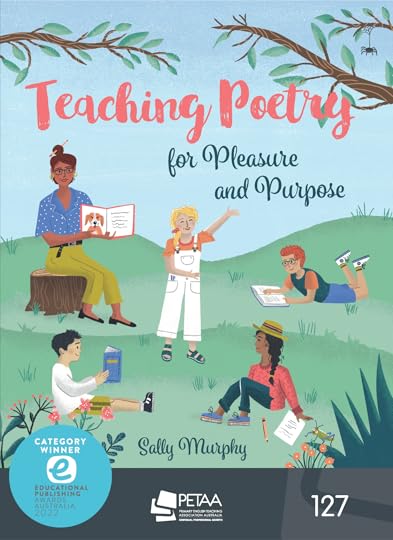 the book I wished I had when I was classroom teaching. It unpacks the Australian curriculum as it relates to poetry and for every Primary School year level it then gives a range of lesson ideas, both reading and writing, and a selection of poems (mostly Australian) and other resource suggestions. I’d be recommending this one even if I didn’t write it.
the book I wished I had when I was classroom teaching. It unpacks the Australian curriculum as it relates to poetry and for every Primary School year level it then gives a range of lesson ideas, both reading and writing, and a selection of poems (mostly Australian) and other resource suggestions. I’d be recommending this one even if I didn’t write it.
I could go on and on listing books here, but sometimes lists can be overwhelming – so here are eight wonderful books for you to get started – but if you need a recommendation for a specific age group or topic, contact me, or comment here, and I will have a suggestion. And if there is a topic you would like me to cover in a future Teacher Tuesday post, hit me up!
And, again, don’t forget that the Dorothea Mackellar Poetry contest is now open for entries. It’s a wonderful opportunity for the young poets in your classroom or your home. 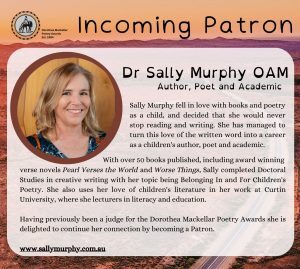 Australia-wide.
Australia-wide.
May 7, 2023
Queen Narelle: One Month to Go!
There is a new monarch! Huzzah! Hurrah! Strike up the band and come bear witness.!
What? Wait! You saw it on the telly? And all over the internet yesterday? Pah! A King on the other side of the world might be interesting to some but I’m talking about a very different monarch. Because (drumroll please) ….
Queen Narelle is almost here!
Who is this new Queen? Why she is THE Queen (especially if you ask her!) and although she may be a little haughty she is also very special.
Did I mention she is also a cat? And the star of my new verse novel?
Well, she is – and I absolutely cannot wait to introduce you to her. But, according to the people at Walker Books I do have to wait. But only for one more month!
And, in the meantime, I am gearing up to share lots of tidbits – some about the book, some about me, and lots of cat fun.
I’ll be sharing some of this here on the website, and other bits and pieces on Instagram and Facebook – so if you don’t already follow me, now’s the time! And, of course, I look forward to also sharing in face to face events. so watch this space for details of launches and appearances (and, if you’d like to visit your school, bookshop, festival, or any other event – let me know)
And, although you have to wait a month to get your hands on a copy, you can preorder now online or drop in to your local bookshop and ask them to save you a copy.
Life is purrfect when there is a new book in the air!
May 1, 2023
What I Read in April 2023
Oh dear! A whole month has gone past since I last found time to post here. Just as well I do a monthly reading round up – it at least makes it hard to go any longer without posting. April has been busy, so I was surprised to realise I still managed to read 13 books. From picture books, to graphic novels to long form historical fiction, with some classics thrown in, it was an eclectic mix as always. Here’s what I read this month:
Books for Children Cloudspotting, by Samantha Tidy & Susannah Crispe (Windy Hollow, 2023). I love a bit of cloud spotting myself – whether its just contemplating the beauty of a cloudy sky or spotting shapes in the clouds. So I was delighted to be asked to launch this picture book in WA. When my copy arrived I discovered that while it is indeed about the loveliness of watching clouds, it is also about family, and father-daughter outings and more, as the young protagonist accompanies her father on a early-morning crabbing trip.
Cloudspotting, by Samantha Tidy & Susannah Crispe (Windy Hollow, 2023). I love a bit of cloud spotting myself – whether its just contemplating the beauty of a cloudy sky or spotting shapes in the clouds. So I was delighted to be asked to launch this picture book in WA. When my copy arrived I discovered that while it is indeed about the loveliness of watching clouds, it is also about family, and father-daughter outings and more, as the young protagonist accompanies her father on a early-morning crabbing trip.
 Friendly Bee and Friends, by Sean E. Avery (Walker Books, 2023). I lvoed this little graphic novel which follows the adventures of Friendly Bee, who wants to be freinds with every bug he meets – including Angry Wasp, Slightly Peckish Caterpillar and even Enormous Hairy Spider, intent on drinking Bee up. Lots of humour and silliness, but a so some gentle messages about friendship and getting along.
Friendly Bee and Friends, by Sean E. Avery (Walker Books, 2023). I lvoed this little graphic novel which follows the adventures of Friendly Bee, who wants to be freinds with every bug he meets – including Angry Wasp, Slightly Peckish Caterpillar and even Enormous Hairy Spider, intent on drinking Bee up. Lots of humour and silliness, but a so some gentle messages about friendship and getting along.
 Little Jiang, by Shirley Marr, illustrated by Katy Jiang (Fremantle Press, 2020). I love Shirley Marr’s writing (and Shirley Marr, who is a lovely friend) but had somehow not read this one, until now. An exciting, heart warming and quirky tale of how Mei Ling, who is born able to see ghosts and seems to be followed by misfortune, manages to save not just her family’s restaurant, but her whole town.
Little Jiang, by Shirley Marr, illustrated by Katy Jiang (Fremantle Press, 2020). I love Shirley Marr’s writing (and Shirley Marr, who is a lovely friend) but had somehow not read this one, until now. An exciting, heart warming and quirky tale of how Mei Ling, who is born able to see ghosts and seems to be followed by misfortune, manages to save not just her family’s restaurant, but her whole town.
 The Machine Gunners, by Robert Westall (Puffin, 1975). I have read this classic many times. I think I probably first read it in high school, and then taught it in my early years of teaching. Now I have a copy that, somehow, came to me having previously been for sale in a second hand bookshop in Cork, Ireland. How did I end up with it? I honestly don’t know, but I do love a well travelled book. All that aside, this was in my to-read cupboard and will now go back on my keepers shelves – I am not ready to part with it, because I know I’ll read it again.
The Machine Gunners, by Robert Westall (Puffin, 1975). I have read this classic many times. I think I probably first read it in high school, and then taught it in my early years of teaching. Now I have a copy that, somehow, came to me having previously been for sale in a second hand bookshop in Cork, Ireland. How did I end up with it? I honestly don’t know, but I do love a well travelled book. All that aside, this was in my to-read cupboard and will now go back on my keepers shelves – I am not ready to part with it, because I know I’ll read it again.
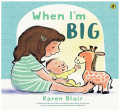 When I’m Big, by Karen Blair (Penguin, 2023). I always love a new Karen Blair picture book – but I was especially excited to get my hands on this one because I won a little piece of the original art, won at an auction at the CBCA WA Annual Night With Our Stars. The book is a gorgeous interpretation of the mixed feelings of a sibling waiting the arrival of a new baby – with fears about being ‘big’ and what that might mean. Gorgeous!Books for Young Adults
When I’m Big, by Karen Blair (Penguin, 2023). I always love a new Karen Blair picture book – but I was especially excited to get my hands on this one because I won a little piece of the original art, won at an auction at the CBCA WA Annual Night With Our Stars. The book is a gorgeous interpretation of the mixed feelings of a sibling waiting the arrival of a new baby – with fears about being ‘big’ and what that might mean. Gorgeous!Books for Young Adults
 Libby Lawrence is Good at Pretending, by Jodi McAlister (Wakefield Press, 2022). I enjoyed this book for older teens. Nineteen year old Libby navigates first sexual encounters, university life and the challenge of trying to figure out how to be herself rather than trying to pretend to be who she thinks she should be.
Libby Lawrence is Good at Pretending, by Jodi McAlister (Wakefield Press, 2022). I enjoyed this book for older teens. Nineteen year old Libby navigates first sexual encounters, university life and the challenge of trying to figure out how to be herself rather than trying to pretend to be who she thinks she should be.
 Invisibly Grace, by Avery McDougall (FortySouth, 2022). I bought this one, along with Libby Lawrence, soon after the CBCA Notables list for 2023 was announced. I love that these lists not only profile good quality books, but also remind readers such as myself of what they might have missed. This one deals with the subject of invisible illnesses, with Grace Turing suffering an undiagnosed chronic illness but determined not to be known as the Sick Girl at the new school she is starting at.Books for Adults
Invisibly Grace, by Avery McDougall (FortySouth, 2022). I bought this one, along with Libby Lawrence, soon after the CBCA Notables list for 2023 was announced. I love that these lists not only profile good quality books, but also remind readers such as myself of what they might have missed. This one deals with the subject of invisible illnesses, with Grace Turing suffering an undiagnosed chronic illness but determined not to be known as the Sick Girl at the new school she is starting at.Books for Adults
 No Mud, No Lotus: The Art of Transforming Suffering, by Thich Naht Hahn. I listened audiobook version of this little book about the reality of suffering as part of being human, and the use of mindfulness and meditation to face and transform suffering. The author is a well known Buddhist monk and the lessons and insights were useful reminders of the importance of mindfulness.
No Mud, No Lotus: The Art of Transforming Suffering, by Thich Naht Hahn. I listened audiobook version of this little book about the reality of suffering as part of being human, and the use of mindfulness and meditation to face and transform suffering. The author is a well known Buddhist monk and the lessons and insights were useful reminders of the importance of mindfulness.
 Frankenstein , by Mary Shelley. Another audiobook listened to in the car. I find this a great way of reading or rereading classic books that I might otherwise not find time for. This particular classic is one I’d not read before, so it was interesting to read the story and get to know the original story which has been reinterpreted a lot of times.
Frankenstein , by Mary Shelley. Another audiobook listened to in the car. I find this a great way of reading or rereading classic books that I might otherwise not find time for. This particular classic is one I’d not read before, so it was interesting to read the story and get to know the original story which has been reinterpreted a lot of times.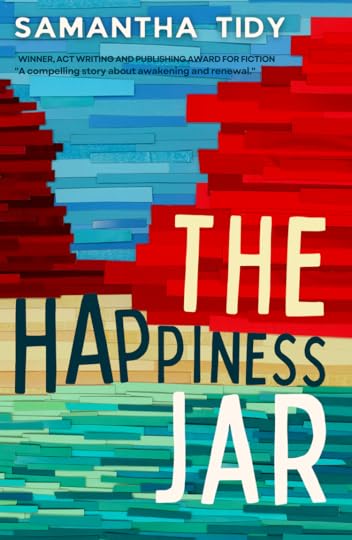 The Happiness Jar, by Samantha Tidy (Storytorch, 2023). I read this as a precursor to launching it, with the author, in WA this month. This is a book that covers a lot of territory – the jar, filled with memories of things that made its owner (Rachel( happy, is found by her mother(Beth) amongst her possessions after she dies. The story traces the journeys of Beth and of her son Matthew, as they try to fulfil Rachel’s wishes – for them each to take half her ashes on journeys that Rachel has planned. Matthew must travel to a remote Kimberley community, and Beth to India. For each the journey is confronting as they overcome their owns pasts and their grief at losing Rachel. Themes including the generational impacts of the Vietnam war on returned soldiers and their families, grief, religion and cystic fibrosis are all worked together into a satisfying whole.
The Happiness Jar, by Samantha Tidy (Storytorch, 2023). I read this as a precursor to launching it, with the author, in WA this month. This is a book that covers a lot of territory – the jar, filled with memories of things that made its owner (Rachel( happy, is found by her mother(Beth) amongst her possessions after she dies. The story traces the journeys of Beth and of her son Matthew, as they try to fulfil Rachel’s wishes – for them each to take half her ashes on journeys that Rachel has planned. Matthew must travel to a remote Kimberley community, and Beth to India. For each the journey is confronting as they overcome their owns pasts and their grief at losing Rachel. Themes including the generational impacts of the Vietnam war on returned soldiers and their families, grief, religion and cystic fibrosis are all worked together into a satisfying whole.
 Redhead by the Side of the Road, by Anne Tyler (Penguin, 2020). I have bene trying my hand at capturing and releasing BookCrossing books, and when I saw this one had been released at a Little Street Library not too far from home, I went there especially to collect it. Then, true to form, it sat in my to-read pile for a while before I finally got to it. It wasn’t a long read – I read it in one day, and while it wasn’t high-action, I enjoyed it. Micah is a man who is very set in his ways and doesn’t see much point in changing. But when a teenager who claims Micah is his father turns up at his doorstep, Micah starts to realise his life is perhaps not going as well as he thinks.
Redhead by the Side of the Road, by Anne Tyler (Penguin, 2020). I have bene trying my hand at capturing and releasing BookCrossing books, and when I saw this one had been released at a Little Street Library not too far from home, I went there especially to collect it. Then, true to form, it sat in my to-read pile for a while before I finally got to it. It wasn’t a long read – I read it in one day, and while it wasn’t high-action, I enjoyed it. Micah is a man who is very set in his ways and doesn’t see much point in changing. But when a teenager who claims Micah is his father turns up at his doorstep, Micah starts to realise his life is perhaps not going as well as he thinks. The Blackout, by Ruth McIver (Audible Original, 2023). This thriller was a free download from Audible, and filled a couple of car trips. Narrated by three characters, each read my a different voice, which makes listening easy, though being about some pretty yucky murders, ‘easy’ is maybe not the best word choice.
The Blackout, by Ruth McIver (Audible Original, 2023). This thriller was a free download from Audible, and filled a couple of car trips. Narrated by three characters, each read my a different voice, which makes listening easy, though being about some pretty yucky murders, ‘easy’ is maybe not the best word choice.
 The Bookbinder of Jericho, by Pip Williams (Affirm Press, 2023). My favourite book in the last couple of years was The Dictionary of Lost Words, so when I heard there was a companion book, I had to read it – and I wasn’t disappointed. I was lucky enough to go a long to a high tea where Pip Williams spoke, and the depth of her knowledge, research and passion was obvious, as it is on the pages. Set, like Dictionary, in Oxford against the backdrop of WW1 and in the publishing world, this is fascinating. The main character, Peggy, is a bookbinder, working at Oxford Press but dreaming of being able to enrol at the university and be part of telling the stories. With appearances by some of the characters from Dictionary, it has made me want to go back and read that – and it is lovely that, as companion books, they can be read independently and in either order.
The Bookbinder of Jericho, by Pip Williams (Affirm Press, 2023). My favourite book in the last couple of years was The Dictionary of Lost Words, so when I heard there was a companion book, I had to read it – and I wasn’t disappointed. I was lucky enough to go a long to a high tea where Pip Williams spoke, and the depth of her knowledge, research and passion was obvious, as it is on the pages. Set, like Dictionary, in Oxford against the backdrop of WW1 and in the publishing world, this is fascinating. The main character, Peggy, is a bookbinder, working at Oxford Press but dreaming of being able to enrol at the university and be part of telling the stories. With appearances by some of the characters from Dictionary, it has made me want to go back and read that – and it is lovely that, as companion books, they can be read independently and in either order.I’d love to hear what you’ve been reading. Talk soon!
April 4, 2023
What I Read in March 2023
It is April, the year is whizzing by (seems to happen every year!) and it is time to look at what I read in March. Nine books this month, as diverse as ever – from a picturebook to a lengthy tome about trauma. The books I have been recommending to others – Minds Went Walking and Dirty Laundry (see below), for quite different reasons.
Anyway, here’s what I read:
Books for Young Readers1. 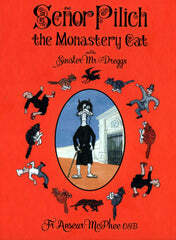 Senor Pilich the Monastery Cat, by Fr. Anscar McPhee OSB (Network Books, 2006). This is a funny little book that I suspect was given to my offspring at some point and has sat on my shelf unloved for a long time. Now I’ve read it, and given it the attention it needed. Told from the perspective of a cat who apprehends a criminal in the New Norcia Monastery. I have my own book coming out in June which is partly told from the perspective of a cat (Queen Narelle) so it’s lovely to read another one.
Senor Pilich the Monastery Cat, by Fr. Anscar McPhee OSB (Network Books, 2006). This is a funny little book that I suspect was given to my offspring at some point and has sat on my shelf unloved for a long time. Now I’ve read it, and given it the attention it needed. Told from the perspective of a cat who apprehends a criminal in the New Norcia Monastery. I have my own book coming out in June which is partly told from the perspective of a cat (Queen Narelle) so it’s lovely to read another one.
2. The Cockatoo Wars (Tales From the Bush Mob), by Helen Milroy (Magabala Books, 2023). I was lucky enough to hear the author talk about this book at the recent CBCA (WA) Night With Our Stars, and, of course, just had to buy a copy, which I look forward to haring with my grandies as well as with my students at university. The tale of two wise mother cockatoos, and their babies – one black and one white – who withdraw from their clans’ ongoing battles and live harmoniously. It becomes up to them to work together to stop a bush fire and restore harmony to the bush.
The Cockatoo Wars (Tales From the Bush Mob), by Helen Milroy (Magabala Books, 2023). I was lucky enough to hear the author talk about this book at the recent CBCA (WA) Night With Our Stars, and, of course, just had to buy a copy, which I look forward to haring with my grandies as well as with my students at university. The tale of two wise mother cockatoos, and their babies – one black and one white – who withdraw from their clans’ ongoing battles and live harmoniously. It becomes up to them to work together to stop a bush fire and restore harmony to the bush.
3. Frank in Time, by Rod Clement (Angus & Robertson, 1998). I picked this up on my local library remainder trolley for $1. There probably should be a law against having remainder trolleys right where I have to walk past them – this wasn’t the only book I bought, but it is the one that caught my eye and made me stop and browse. I really like Rod Clement’s illustration style and this humorous take on history involves the young protagonist and his dog (Frank) taking a trip to the museum and comparing the past with today. In each illustration, Frank is either part of the history, or up to some mischief.
4.  Fog A Dox, by Bruce Pascoe (Magabala, 2012). Last year I realised there were some gaps in y reading of notable titles by First nations writers, and I set about trying to rectify this. I am unsure why I hadn’t read this book, because I certainly knew about it and admire Pascoe’s other works. I adore this book and am glad I now own it – a story of unusual friendships, kindness and respect.
Fog A Dox, by Bruce Pascoe (Magabala, 2012). Last year I realised there were some gaps in y reading of notable titles by First nations writers, and I set about trying to rectify this. I am unsure why I hadn’t read this book, because I certainly knew about it and admire Pascoe’s other works. I adore this book and am glad I now own it – a story of unusual friendships, kindness and respect.
Books for Adults
 Minds Went Walking: Paul Kelly’s Songs Reimagined, curated by Jock Serong, Mark Smith & Neil A. White (Fremantle Press, 2022). I’ve had this one for a little while but glad it finally rose to the top of the pile, even though it has left me singing Paul Kelly songs everywhere I go. Not a bad thing really. Each contributor has been inspired by a single Kelly song, writing about their own experiences with the song, or a creative response to the song, making each contribution unique.
Minds Went Walking: Paul Kelly’s Songs Reimagined, curated by Jock Serong, Mark Smith & Neil A. White (Fremantle Press, 2022). I’ve had this one for a little while but glad it finally rose to the top of the pile, even though it has left me singing Paul Kelly songs everywhere I go. Not a bad thing really. Each contributor has been inspired by a single Kelly song, writing about their own experiences with the song, or a creative response to the song, making each contribution unique.
 Someone Else’s Shoes, by Jojo Moyes (Penguin Books, 2023). I listened to the audio version of this, expecting it be light and fluffy. And it was certainly light in places, but was really a story of sisterhood between women and I found myself cheering them on. A good driving story.
Someone Else’s Shoes, by Jojo Moyes (Penguin Books, 2023). I listened to the audio version of this, expecting it be light and fluffy. And it was certainly light in places, but was really a story of sisterhood between women and I found myself cheering them on. A good driving story.
 Not Now, Not Ever: Ten Years On From the Misogyny Speech, edited by Julia Gillard (Vintage, 2022). I started reading this on International Women’s Day, which was a good time to do it. I laughed, I cried, I got angry and I thought A LOT.
Not Now, Not Ever: Ten Years On From the Misogyny Speech, edited by Julia Gillard (Vintage, 2022). I started reading this on International Women’s Day, which was a good time to do it. I laughed, I cried, I got angry and I thought A LOT.
 Dirty Laundry: Why adults with ADHD are so ashamed and what we can do to help , by Richard Pink and Roxanne Emery. I listened to this on Audible, but will be buying the print copy if I can find it in Australia. Written by a couple who are also, apparently, Tiktok famous for their videos about living with ADHD, I found this easy to listen to, and enjoyed hearing about ADHD from the perspective of a woman who lives with it and her husband. Really useful insights, and a lot I could relate to.
Dirty Laundry: Why adults with ADHD are so ashamed and what we can do to help , by Richard Pink and Roxanne Emery. I listened to this on Audible, but will be buying the print copy if I can find it in Australia. Written by a couple who are also, apparently, Tiktok famous for their videos about living with ADHD, I found this easy to listen to, and enjoyed hearing about ADHD from the perspective of a woman who lives with it and her husband. Really useful insights, and a lot I could relate to.
 The Body Keeps the Score: Mind, Brain and Body in the Transformation of Trauma
The Body Keeps the Score: Mind, Brain and Body in the Transformation of Trauma(Penguin, 2014). Fairly heavy going because it is about how trauma impacts both the mind and the body, and discusses case histories, therapies and more, mostly from the viewpoint of the therapeutic practitioner. Sometimes though, hard is worthwhile, and I found these insights both informative and useful.
Total for the year to date is 32. I’d love to hear what you’ve been reading.
March 20, 2023
Teacher Tuesday: World Poetry Day
It’s Teacher and it’s also World Poetry Day. A whole day just to celebrate poetry!
So, here’s a poem from me that you can use in your classroom, or just listen to for your self:
And here it is written down so you can see the patterns, and perhaps use as a mentor text:
Milkshakeby Sally MurphyThe sea’s been churning icecream
Though it’s too salty to eat
It’s been rolling rolling rolling
In an icy wintry beat.
The sea’s been frothing milkshakes
Though they’re briny to the taste
It’s been mixing mixing mixing
With a hustle and a haste
The sea’s been blending smoothies
Though they’re not for you or me
It’s been churning churning churning
In a chilly stormy spree
The sea’s now washing dishes
With a bubble and a slosh
See it scrubbing scrubbing scrubbing
In its busy midday wash.
(copyright Sally Murphy, 2016)
World Poetry Day is a wonderful day to think about poetry – but also to think about entering the Dorothea Mackellar Poetry Awards. You can do this as a whole class activity or you might make it optional. Either way, what a wonderful, authentic way to help your young poets have their work read by a published poet (the judges are both established poets) and, of course, the chance to win a prize.
If you’d like hints or tips on ways to to write poetry for the awards or any other time, you’ll find lots here on my website, but feel free to ask questions in the comments.
Have a wonderful World Poetry Day!
March 13, 2023
Teacher Tuesday: The Kid Under the Tree
It’s Teacher Tuesday where I usually offer an activity or lesson idea that you can use in your classroom. But this week it isn’t either of those I’m offering: just a little anecdote and a bit of a plea.
Last week I shared, among other things, this poem, written during a writing workshop as an example of a sad poem.

Then, later in the week I was lucky enough to be part of the Harvey Literary Festival where I spoke to children in years 3 and 4 from three different schools. Partly because it was semi local I found myself speaking more about my own childhood, growing up in Collie.
Later I read the opening pages of Pearl Verses the World and, as always, turned the book so show the beautiful illustrations.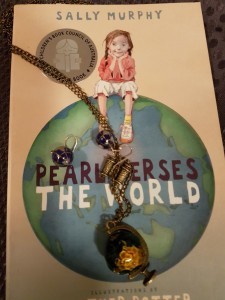 I pointed to Pearl, in her group of one under a tree. And, as I did so, I noticed the book on the ground next to her. And felt a little jolt of recognition.
I pointed to Pearl, in her group of one under a tree. And, as I did so, I noticed the book on the ground next to her. And felt a little jolt of recognition.
“See that –” I said to the group. “Pearl is just like me. I was that girl. The one who sat under a tree with a book.”
And I went on to briefly explain what I meant. So many many days in school I found the play ground a challenging beast. We were let out for a snack and a play – but playing required people to play with. I did have friends (and some of those friends are still in my life) but I also found relationships really challenging – I did not understand how to just join a game if I hadn’t been specifically invited, or if my friend was (shock, horror) playing with someone else. And there were a lot of times that I felt I had no friends.
So, I learnt very early that a book was the solution. I would find a spot – under the weeping willow in the playground was my favourite – and I would open that book and I would read. That way no one would know I was lonely, but also, I felt less lonely, because I loved reading, and I connected with the characters in the books.
Later I learnt that the library could also be a safe place, and I added this to the ways to avoid looking and feeling alone. It’s only many many years later that I realise my social awkwardness and feeling of not belonging, of not understanding the rules of friendships was (is!) part of my neurodivergence. As an adult I’ve learnt other coping strategies, and built social skills, but I am still often awkward or nervous in situations where I feel like I don’t know the rules.
So, why am I sharing this on Teacher Tuesday? Because of the way one child responded to this story.
This child listened, then put up their hand:
“So,” they said. “Would you say books were your lifeline?”
And I realised two things – one, that this kid was very very perceptive and perhaps knew better than me the point of what I was saying. And two, I was one kid under a tree, but these kids are in every playground, every school. Under a tree with a book, in the library, bouncing a ball on their own. And sometimes we see them and know that this child is lonely – but sometimes we don’t. Because a kid reading a book could indeed be just engrossed in the a really good story. But if they’re on their own, rather than reading alongside friends, there is a good chance that they, like me, are clutching a lifeline.
So, my Teacher Tuesday plea is that, in amongst the million other wonderful things you do as a teacher, please watch out for the kid under the tree. Do what you can to nurture them, to include them, to show them that they do belong. Stop in the playground and ask them about the book – or recommend another one for next. Even better, ask them about that book in the classroom, where another reader may hear and connect. Gently check in that the child is okay. Pearl is under that tree because the things happening in her life are really big – and she needs some space to process, even though, at the same time, she feels lonely.
You don’t have to be the total solution for that child, but you can take the opportunity to be part of it, by joing themunder that tree – which isn’t such a bad thing to do. 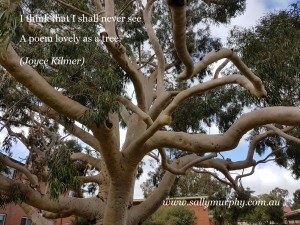
March 9, 2023
Poetry Friday: Where the Pelican Builds Her Nest
It’s Poetry Friday. Last week I shared Dorothea Mackellar’s famous ‘My Country’ and it had such a lovely response that I thought I might share another classic Australian poem this week.
This one is perhaps less well known. It’s a ballad, by a Scottish-born Australian poem Mary Hannay-Foott. It’s a little haunting, but one I’m very fond of – enough that I included it in my Teaching Poetry book.
Where the Pelican Builds Her Nest
The horses were ready, the rails were down,
But the riders lingered still
One had a parting word to say,
And one had his pipe to fill.
Then they mounted, one with a granted prayer,
And one with a grief unguessed.
“We are going,” they said, as they rode away
“Where the Pelican builds her nest!”
They had told us of pastures wide and green,
To be sought past the sunset’s glow;
Of rifts in the ranges by opal lit;
And gold ‘neath the river’s flow.
And thirst and hunger were banished words
When they spoke of that unknown West;
No drought they dreaded, no flood they feared,
Where the pelican builds her nest!
The creek at the ford was but fetlock deep
When we watched them crossing there;
The rains have replenished it thrice since then,
And thrice has the rock lain bare.
But the waters of Hope have flowed and fled,
And never from blue hill’s breast
Come back – by the sun and the sands devoured
Where the pelican builds her nest!
That last stanza is a wee bit heart breaking, and I believe that the poem was written about two brothers who went off searching for fertile farming land (the pelicans build nests where there is water and food) and never returned. There is more about the poem here.
Coincidentally, I shared earlier this week, a lesson idea for guiding students to write sad poems. It is only as I write this post that I realise this poem is a really good example.
I’m off today to a small literary festival not far from home, so I’ll be checking in on the rest of the Poetry Friday fun a little later. Heidi will be hosting the roundup. Have a great Friday!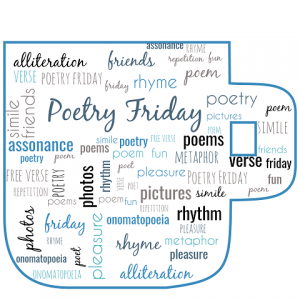
March 6, 2023
Teacher Tuesday: Writing ‘Sad’ Poems Using Toppling and Pearl Verses the World as Mentor Texts
Hello and welcome to Teacher Tuesday. My goal is to post here every Tuesday with classroom ideas for Australian teachers (and teachers further abroad) but last week I didn’t post because it was one of the busiest weeks of my work year. It was the first week of semester at Curtin university where I work, and I also spent part of the week running writing masterclasses for the Literature Centre in their Talented Young Writers Program.
One of the most delightful things about being a writer is getting to meet and share young readers and writers and ,hopefully ,inspire them on their way to becoming master writers, or just better writers, so I thought this week I would share a version of what I did as part of those sessions last week. I found a really beautiful way to finish each of these extended writing workshops.
During the day we examined the basic tools of a poet: things like simile, metaphor, and onomatopoeia as well as more nuanced tools such as using rhythm and pace even when you’re writing free verse, or layering meaning and connecting with character and place in poetic form. Then at the end of each day I that I wanted to bring all that together and I asked the students to make me cry. What I mean by this is I asked them to write a sad poem.
So what I’m sharing here today is a shortened form of that exercise. Firstly, as I said, we’d covered a lot of poetic techniques before I asked them to do this so if you were doing this in your classroom I would suggest that you would really need to unpack the mentor texts I’m going to suggest or that you already have been working a lot with poetry and therefore are confident that your students will connect either with the mentor texts or with your instructions but I also think this is an exercise that can stand alone.
This exercise is suitable for upper primary right through to secondary and it’s also suitable for adult writers. Firstly, start with actually sharing some examples of sad poetry. The two examples that I’m recommending are firstly from Pearl Verses the World the scene that goes from page 44 to page 49. If you don’t know the book this is a really intense piece of news that Pearl is receiving and it also is quite sad. When you read that text to your readers you can emphasise the way that there’s not a lot of mention of crying, there is use of repetition and other poetic techniques, but there’s also touches of humour in the lead up to that news being delivered as well as a sense of foreboding that, although it’s humorous, something’s about to happen.
with actually sharing some examples of sad poetry. The two examples that I’m recommending are firstly from Pearl Verses the World the scene that goes from page 44 to page 49. If you don’t know the book this is a really intense piece of news that Pearl is receiving and it also is quite sad. When you read that text to your readers you can emphasise the way that there’s not a lot of mention of crying, there is use of repetition and other poetic techniques, but there’s also touches of humour in the lead up to that news being delivered as well as a sense of foreboding that, although it’s humorous, something’s about to happen.
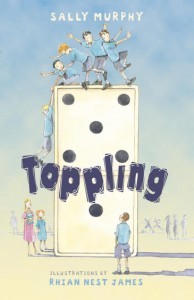 Next, read the second text – from Toppling. Again in this scene John is receiving bad news – you can see there’s a theme here. The pages for this exercise are page 59 to page 63 .
Next, read the second text – from Toppling. Again in this scene John is receiving bad news – you can see there’s a theme here. The pages for this exercise are page 59 to page 63 .
If students haven’t read the rest of the either of these texts I would suggest that you decide exactly where to start and finish, but if they’ve already read the book in class, those are the pages that I recommend. You could do this exercise using other sad poems or sad text extracts you’re more familiar with. I recommend using more than one mentor text to encourage students to look at the differences as well as the similarities.
After you’ve read both passages and you’ve discussed them, the next thing is that you want your students to write. The prompt that I gave to the young these writers was that I wanted them to write me a sad poem and make me cry, and I felt quite confident with doing that because I knew that these students would get what I was talking about having worked directly with me for several hours. I then gave them a choice of two topics:
1. Write a poem about something sad.
2. Write a poem about someone receiving bad news.
I have chosen these because these particular scenes from my two books are both a combination of something quite sad but also in both cases the child in the book is receiving bad news.
Giving young writers a choice that if they actually don’t want to explore something really terrible, the bad news could be a bit flippant. It could be for example someone being told that the Dockers had lost a football game, but I would encourage them to really explore emotion.
One danger in asking children to write a sad poem is that they may just write using lots of ‘sad’ words – crying, tears, sorrow, I feel sad, I was sad and so on. So I really believe in modelling writing either before they write or while they write. As s an educator as well as an author when I ask writers to do an activity I usually also do the same activity on a whiteboard so that they can see my process but also so they have an extra model. I don’t make that example a perfect example, instead I write it on the spot.
I thought I might share with you these three examples (pictured – click on them to make them larger) which are three different sad poems that I wrote on three different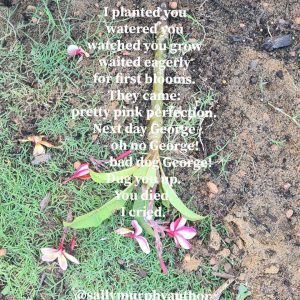 days For context I did also afterwards share some of the back story on the frangipani poem because I felt that the missing piece of that puzzle was that why I was so sad wasn’t just about the tree – it was also that that tree marked the burial spot of my previous dog. And the Mundy poem is about David Mundy’s last game. I started by thin
days For context I did also afterwards share some of the back story on the frangipani poem because I felt that the missing piece of that puzzle was that why I was so sad wasn’t just about the tree – it was also that that tree marked the burial spot of my previous dog. And the Mundy poem is about David Mundy’s last game. I started by thin
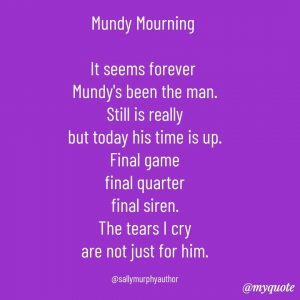
king that I’d write something a bit light hearted by calling it Mundy Mourning with a play on words but actually it ended up bringing me back to what happened at his last game. I surprised myself because I knew I’d feel sad because I’m a Dockers fan. I knew I might cry but when the game finished I cried so much that I almost needed help to leave and that was because it made me think about the fact that my sister who passed away a few years ago loved Mundy as a football player, would have loved to have been there. She would have been cheering and clapping and maybe crying a little bit to see him leave. But she wasn’t there and so when I cried I cried for his last game and then I cried with grief for my sister.

So I’m sharing these poems as examples but I’m happy for you to use one or more of them as mentor texts although I don’t know whether they stand alone without either a tiny bit of backstory or with those other richer texts that
I’ve recommended in Toppling or Pearl Verses the World. They are actually unedited examples of what I wrote on the spot .
SO after the mentor texts and examples simply hand the task over and ask students to write. You can see there is not a lot of structure because I like to trust writers to take the exercise in their own direction, but I also roam and help where needed, especially in a mixed ability group, where more scaffolding might be needed by some students. You know your students, and the amount of support they need, best.
Lastly, if you don’t know about the amazing work of the The Literature Centre in Fremantle, formerly called the Children’s Literature centre or just called the Lit Centre, their Young Writers Programs run from Year 6 all the way through the year 12, some of the most amazing writing offerings for young writers that I’m aware of ,and well worth taking your young writers along to if you have the opportunity.
Thanks for reading, thanks for teaching our next generation, and I would love to hear if this exercise is useful for you. Maybe you could use it to inspire some of your students to enter the Dorothea Mackellar Poetry Contest, which is now open to entries – details here.
See you next Tuesday.
Teacher Tuesday: Writing ‘Sad’ Poems Using Topping and Pearl Verses the World as Mentor Texts
Hello and welcome to Teacher Tuesday. My goal is to post here every Tuesday with classroom ideas for Australian teachers (and teachers further abroad) but last week I didn’t post because it was one of the busiest weeks of my work year. It was the first week of semester at Curtin university where I work, and I also spent part of the week running writing masterclasses for the Literature Centre in their Talented Young Writers Program.
One of the most delightful things about being a writer is getting to meet and share young readers and writers and ,hopefully ,inspire them on their way to becoming master writers, or just better writers, so I thought this week I would share a version of what I did as part of those sessions last week. I found a really beautiful way to finish each of these extended writing workshops.
During the day we examined the basic tools of a poet: things like simile, metaphor, and onomatopoeia as well as more nuanced tools such as using rhythm and pace even when you’re writing free verse, or layering meaning and connecting with character and place in poetic form. Then at the end of each day I that I wanted to bring all that together and I asked the students to make me cry. What I mean by this is I asked them to write a sad poem.
So what I’m sharing here today is a shortened form of that exercise. Firstly, as I said, we’d covered a lot of poetic techniques before I asked them to do this so if you were doing this in your classroom I would suggest that you would really need to unpack the mentor texts I’m going to suggest or that you already have been working a lot with poetry and therefore are confident that your students will connect either with the mentor texts or with your instructions but I also think this is an exercise that can stand alone.
This exercise is suitable for upper primary right through to secondary and it’s also suitable for adult writers. Firstly, start with actually sharing some examples of sad poetry. The two examples that I’m recommending are firstly from Pearl Verses the World the scene that goes from page 44 to page 49. If you don’t know the book this is a really intense piece of news that Pearl is receiving and it also is quite sad. When you read that text to your readers you can emphasise the way that there’s not a lot of mention of crying, there is use of repetition and other poetic techniques, but there’s also touches of humour in the lead up to that news being delivered as well as a sense of foreboding that, although it’s humorous, something’s about to happen.
with actually sharing some examples of sad poetry. The two examples that I’m recommending are firstly from Pearl Verses the World the scene that goes from page 44 to page 49. If you don’t know the book this is a really intense piece of news that Pearl is receiving and it also is quite sad. When you read that text to your readers you can emphasise the way that there’s not a lot of mention of crying, there is use of repetition and other poetic techniques, but there’s also touches of humour in the lead up to that news being delivered as well as a sense of foreboding that, although it’s humorous, something’s about to happen.
 Next, read the second text – from Toppling. Again in this scene John is receiving bad news – you can see there’s a theme here. The pages for this exercise are page 59 to page 63 .
Next, read the second text – from Toppling. Again in this scene John is receiving bad news – you can see there’s a theme here. The pages for this exercise are page 59 to page 63 .
If students haven’t read the rest of the either of these texts I would suggest that you decide exactly where to start and finish, but if they’ve already read the book in class, those are the pages that I recommend. You could do this exercise using other sad poems or sad text extracts you’re more familiar with. I recommend using more than one mentor text to encourage students to look at the differences as well as the similarities.
After you’ve read both passages and you’ve discussed them, the next thing is that you want your students to write. The prompt that I gave to the young these writers was that I wanted them to write me a sad poem and make me cry, and I felt quite confident with doing that because I knew that these students would get what I was talking about having worked directly with me for several hours. I then gave them a choice of two topics:
1. Write a poem about something sad.
2. Write a poem about someone receiving bad news.
I have chosen these because these particular scenes from my two books are both a combination of something quite sad but also in both cases the child in the book is receiving bad news.
Giving young writers a choice that if they actually don’t want to explore something really terrible, the bad news could be a bit flippant. It could be for example someone being told that the Dockers had lost a football game, but I would encourage them to really explore emotion.
One danger in asking children to write a sad poem is that they may just write using lots of ‘sad’ words – crying, tears, sorrow, I feel sad, I was sad and so on. So I really believe in modelling writing either before they write or while they write. As s an educator as well as an author when I ask writers to do an activity I usually also do the same activity on a whiteboard so that they can see my process but also so they have an extra model. I don’t make that example a perfect example, instead I write it on the spot.
I thought I might share with you these three examples (pictured – click on them to make them larger) which are three different sad poems that I wrote on three different days For context I did also afterwards share some of the back story on the frangipani poem because I felt that the missing piece of that puzzle was that why I was so sad wasn’t just about the tree – it was also that that tree marked the burial spot of my previous dog. And the Mundy poem is about David Mundy’s last game. I started by thin
days For context I did also afterwards share some of the back story on the frangipani poem because I felt that the missing piece of that puzzle was that why I was so sad wasn’t just about the tree – it was also that that tree marked the burial spot of my previous dog. And the Mundy poem is about David Mundy’s last game. I started by thin

king that I’d write something a bit light hearted by calling it Mundy Mourning with a play on words but actually it ended up bringing me back to what happened at his last game. I surprised myself because I knew I’d feel sad because I’m a Dockers fan. I knew I might cry but when the game finished I cried so much that I almost needed help to leave and that was because it made me think about the fact that my sister who passed away a few years ago loved Mundy as a football player, would have loved to have been there. She would have been cheering and clapping and maybe crying a little bit to see him leave. But she wasn’t there and so when I cried I cried for his last game and then I cried with grief for my sister.

So I’m sharing these poems as examples but I’m happy for you to use one or more of them as mentor texts although I don’t know whether they stand alone without either a tiny bit of backstory or with those other richer texts that
I’ve recommended in Toppling or Pearl Verses the World. They are actually unedited examples of what I wrote on the spot .
SO after the mentor texts and examples simply hand the task over and ask students to write. You can see there is not a lot of structure because I like to trust writers to take the exercise in their own direction, but I also roam and help where needed, especially in a mixed ability group, where more scaffolding might be needed by some students. You know your students, and the amount of support they need, best.
Lastly, if you don’t know about the amazing work of the The Literature Centre in Fremantle, formerly called the Children’s Literature centre or just called the Lit Centre, their Young Writers Programs run from Year 6 all the way through the year 12, some of the most amazing writing offerings for young writers that I’m aware of ,and well worth taking your young writers along to if you have the opportunity.
Thanks for reading, thanks for teaching our next generation, and I would love to hear if this exercise is useful for you. Maybe you could use it to inspire some of your students to enter the Dorothea Mackellar Poetry Contest, which is now open to entries – details here.
See you next Tuesday.



